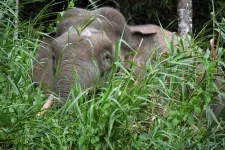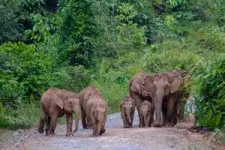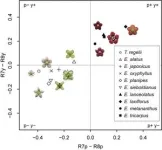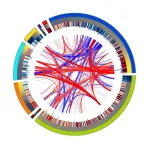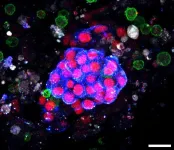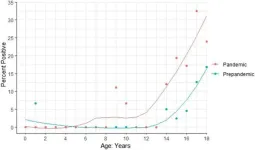(Press-News.org) New research has discovered the power of large national parks to not only enhance bird diversity inside their borders but boost mammal diversity in nearby unprotected areas.
The University of Queensland’s Dr Matthew Luskin said the study, which involved using more than 2,000 cameras and bird surveys across Southeast Asia, reveals for the first time the benefit of expanding protected land areas around the globe beyond park boundaries.
“Protected area expansions are often a difficult and expensive process, but our results show they are absolutely worth it,” Dr Luskin said.
“We already know that protected areas can reduce logging – and you can see that from satellite imagery – but what you can’t see is the number of animals inside the forest.
“We also know that marine parks often report biodiversity spillover, whereby fish reproduce successfully inside park boundaries and their offspring disperse, benefiting surrounding habitats.
“What we didn’t know until now was whether terrestrial land parks are successful in providing biodiversity spillover, or simply displace biodiversity losses to surrounding areas.
“Our analysis has revealed the benefits parks, specifically large ones, have to terrestrial mammals.
“Specifically, we found that when comparing unprotected areas nearby large reserves to unprotected areas that didn’t border large reserves, large reserves generated an up to 194 per cent boost in mammal diversity.”
Researchers say the results provide a much-needed conservation win for large reserves in the mega-biodiverse Southeast Asian region, which is under threat from a multitude of factors, namely hunting and deforestation.
“Hunting is a key concern for Southeast Asia and a prime suspect for why diversity has often been assumed to decline outside of parks,” Dr Luskin said.
“Hunters are mobile and so we had thought that hunting bans within park boundaries may only displace these activities to nearby unprotected areas, undermining their net benefit.
“It’s common to see hunters inside and outside of parks in many countries and we expected that hunters’ removing game animals would reduce diversity, but it appears parks limit hunting to the extent it doesn’t completely remove these animals.
“Another likely benefit of large parks is they support wide-ranging animals, such as tigers or elephants, that move across entire landscapes, including protected and unprotected areas.”
Lead author, Dr Jedediah Brodie from the University of Montana, and the Universiti Malaysia Sarawak, said the teams’ work provides a clear motivation for future park designs to push for larger size as a key factor.
“This would fit nicely with the UN’s 30 by 2030 goal, which would increase protected areas to 30 per cent of all land,” Dr Brodie said.
“Larger parks routinely had higher bird diversity, and considering the UN’s 30 by 2030 goal, these findings support the creation of fewer larger parks compared to many smaller ones.”
Moving forward, researchers aim to quantify shifts in abundance of mammals and birds inside and outside of parks and expand their work to other regions, including Australia.
“I suspect that parks will support mammal abundances even more than diversity,” Dr Brodie said.
“It’s certainly an interesting prospect and the team looks forward to clarifying the relationship between park types and biodiversity to ensure optimal conservation outcomes.”
This research is published in Nature.
END
Wildlife overflow enriches biodiversity beyond park boundaries
2023-08-23
ELSE PRESS RELEASES FROM THIS DATE:
Graphene: More magic starts when flatness ends
2023-08-23
Researchers from The University of Manchester and the University of Warwick finally solved the long-standing puzzle of why graphene is so much more permeable to protons than expected by theory.
A decade ago, scientists at The University of Manchester demonstrated that graphene is permeable to protons, nuclei of hydrogen atoms. The unexpected result started a debate in the community because theory predicted that it would take billions of years for a proton to permeate through graphene’s dense crystalline structure. This had led to suggestions that protons permeate not through the crystal lattice itself, ...
Researchers fully sequence the Y chromosome for the first time
2023-08-23
What was once the final frontier of the human genome — the Y chromosome — has just been mapped out in its entirety.
Led by the National Human Genome Research Institute (NHGRI), a team of researchers at the National Institute of Standards and Technology (NIST) and many other organizations used advanced sequencing technologies to read out the full DNA sequence of the Y chromosome — a region of the genome that typically drives male reproductive development. The results of a study ...
New research shows how cancer rewires a key immune pathway to spread
2023-08-23
A study led by researchers at Memorial Sloan Kettering Cancer Center (MSK) and Weill Cornell Medicine discovered a new relationship between cancer cells and the immune system, and shows how cancer can selfishly hijack a normally helpful immune pathway.
Usually, activation of this key immune pathway — called the STING pathway — triggers a strong inflammatory response that protects the body from foreign and unhealthy cells. But prolonged activation of the same pathway leads to a desensitization and ultimately to a “rewiring” of cellular signaling, which aids and abets cancer’s spread, the researchers found.
“You might think of ...
Graphene discovery could help generate hydrogen cheaply and sustainably
2023-08-23
Researchers from The University of Warwick and the University of Manchester have finally solved the long-standing puzzle of why graphene is so much more permeable to protons than expected by theory.
A decade ago, scientists at The University of Manchester demonstrated that graphene is permeable to protons, nuclei of hydrogen atoms.
The unexpected result started a debate in the community because theory predicted that it would take billions of years for a proton to permeate through graphene’s dense crystalline structure. ...
Adding immunity to human kidney-on-a-chip advances cancer drug testing
2023-08-23
By Benjamin Boettner
(Boston) — A growing repertoire of cell and molecule-based immunotherapies is offering patients with indomitable cancers new hope by mobilizing their immune systems against tumor cells. An emerging class of such immunotherapeutics, known as T cell bispecific antibodies (TCBs), are of growing importance with several TCBs that the U.S. Food and Drug Administration (FDA) approved for the treatment of leukemias, lymphomas, and myelomas. These antibody drugs label tumor cells with one of their ends, and attract immune cells with another end to coerce them into tumor cell killing.
One major challenge in the development of TCBs and other immunotherapy ...
Fungus gnats as pollinators not pests
2023-08-23
Many plants and crops rely on insects to pollinate them so they can reproduce. A new study has shown that several flowering plants from the group Euonymus are pollinated by fungus gnats, a dipteran insect. Specifically, they pollinate Euonymus plants which have red-petaled flowers with short stamens and yogurt-like scent. Although fungus gnats are known to pollinate hundreds of plant species, this study shows that the particular traits of red Euonymus flowers were likely to have been acquired via pollination syndrome, evolving over a process of natural selection to be pollinated specifically by fungus gnats. This research highlights the important role of Diptera, which are commonly regarded ...
Solar powered irrigation: a game-changer for small-scale farms in sub-Saharan Africa
2023-08-23
In sub-Saharan Africa 80% of agricultural production is from smallholder farmers, who face constraints on increasing farm productivity resulting in a large yield gap. Extensive rain-fed agriculture (90% of all cropland) under unpredictable and erratic rainfall pattern is a leading cause of the low productivity and food insecurity in Africa, together with a low degree of mechanization. This has been reinforcing a persistent poverty trap, triggered by cyclical famines that are jeopardizing local development opportunities.
In a new IIASA-led study as part of the research project Renewables for African Agriculture (RE4AFAGRI), an international ...
Looking out for kids: a case for better pediatric trauma interventions
2023-08-23
In the weeks following the onset of the COVID-19 pandemic, public health directives called for masking, social distancing, social isolation, and stay-at-home orders. Apart from the severe medical consequences as a direct result of the pandemic, the ensuing social isolation had far-reaching impacts on children. The pandemic control measures affected the pediatric population by increasing mental distress, limiting physical activity, changing sleep patterns, and reducing emergency room visits. Unfortunately, the scope of pediatric trauma during the pandemic remains ...
SwRI investigates the efficiency impact of smart-technology-enabled vehicles
2023-08-23
SAN ANTONIO — August 23, 2023 — A Southwest Research Institute project funded by the U.S. Department of Energy (DOE) has demonstrated an average of 15% energy savings when vehicles outfitted with connected and automated vehicle systems, or CAVs, are introduced into traffic.
CAVs use wireless smart technology to communicate with other CAVs and traffic infrastructure. SwRI’s eco-driving framework uses custom software and predictive powertrain algorithms to enable human drivers to make more efficient driving ...
Nemours Children’s Health researchers to present at World Congress of Pediatric Cardiology and Cardiac Surgery
2023-08-23
JACKSONVILLE, Fla. (August 23, 2023) – Researchers from Nemours Children’s Health will present a range of studies at the World Congress of Pediatric Cardiology and Cardiac Surgery, Aug. 27 – Sept. 1 in Washington D.C., the leading global conference in the field. Nemours Children’s presentations will highlight advances in complex congenital heart disease, prevention, cardiomyopathy in rare diseases, and the benefit of integration with other areas like psychology and telehealth.
"In pediatric cardiac surgery, the Nemours Children’s Cardiac Center has pioneered a number of procedures, and we are pleased to share our new findings with researchers and clinicians ...
